Exploring Obesity: Parental Roles, Social, Genetic Factors - Essay
VerifiedAdded on 2023/03/31
|7
|1962
|302
Essay
AI Summary
This essay provides a comprehensive overview of obesity, starting with its conceptualization and definition, differentiating it from being overweight and highlighting its historical perception. It delves into the role of family and parents in battling obesity, emphasizing the importance of parental influence on children's eating habits and physical activities. The essay further discusses obesity as a social issue, citing statistics and the impact on individuals' quality of life, including health outcomes and social stigma. Additionally, it explores the genetic factors contributing to obesity, including the influence of genetics on fat storage and body composition, as well as epigenetic triggers during pregnancy. The essay concludes with a comparative analysis of genetic and general factors and the essential role of parents in curbing obesity in both scenarios.
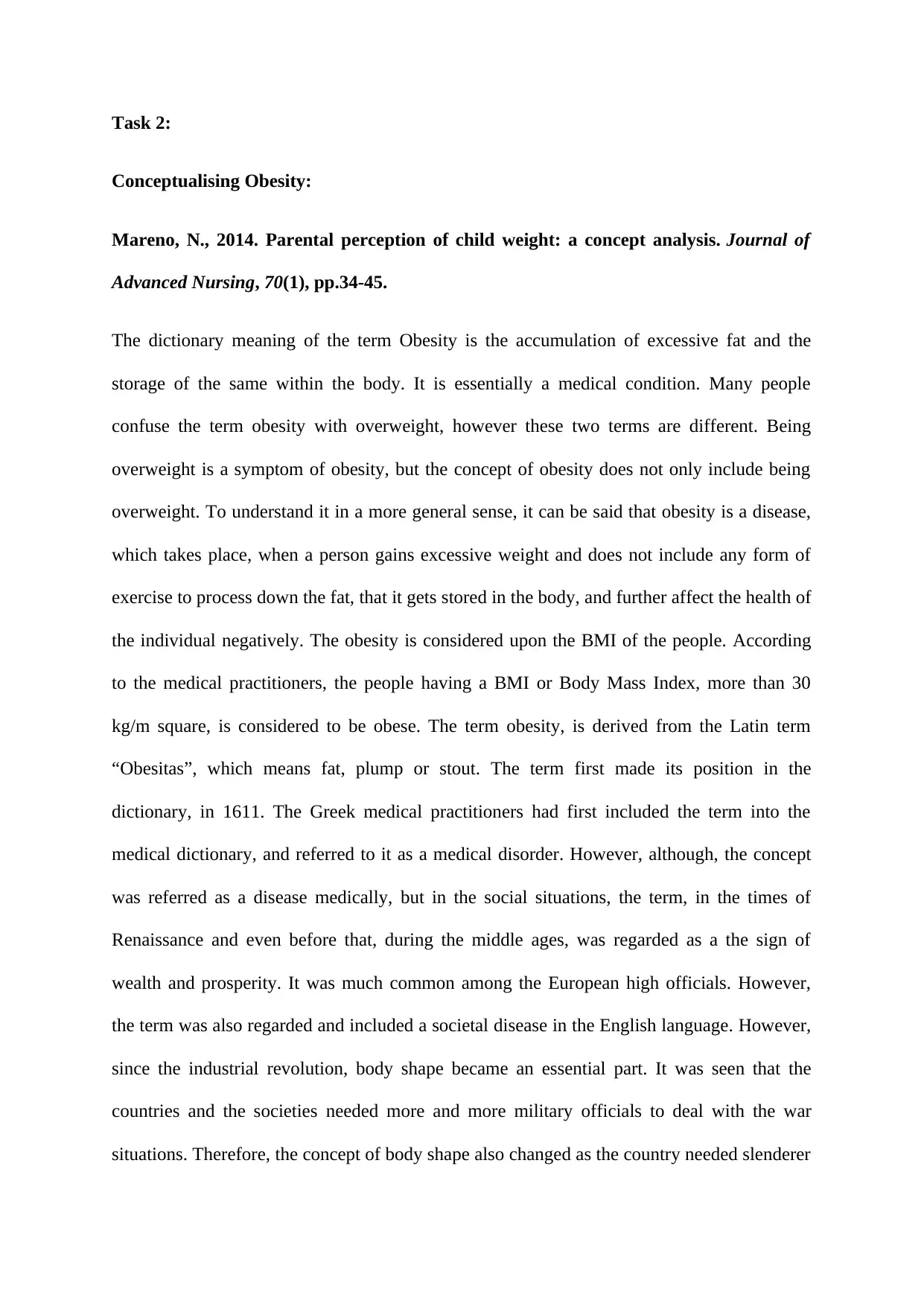
Task 2:
Conceptualising Obesity:
Mareno, N., 2014. Parental perception of child weight: a concept analysis. Journal of
Advanced Nursing, 70(1), pp.34-45.
The dictionary meaning of the term Obesity is the accumulation of excessive fat and the
storage of the same within the body. It is essentially a medical condition. Many people
confuse the term obesity with overweight, however these two terms are different. Being
overweight is a symptom of obesity, but the concept of obesity does not only include being
overweight. To understand it in a more general sense, it can be said that obesity is a disease,
which takes place, when a person gains excessive weight and does not include any form of
exercise to process down the fat, that it gets stored in the body, and further affect the health of
the individual negatively. The obesity is considered upon the BMI of the people. According
to the medical practitioners, the people having a BMI or Body Mass Index, more than 30
kg/m square, is considered to be obese. The term obesity, is derived from the Latin term
“Obesitas”, which means fat, plump or stout. The term first made its position in the
dictionary, in 1611. The Greek medical practitioners had first included the term into the
medical dictionary, and referred to it as a medical disorder. However, although, the concept
was referred as a disease medically, but in the social situations, the term, in the times of
Renaissance and even before that, during the middle ages, was regarded as a the sign of
wealth and prosperity. It was much common among the European high officials. However,
the term was also regarded and included a societal disease in the English language. However,
since the industrial revolution, body shape became an essential part. It was seen that the
countries and the societies needed more and more military officials to deal with the war
situations. Therefore, the concept of body shape also changed as the country needed slenderer
Conceptualising Obesity:
Mareno, N., 2014. Parental perception of child weight: a concept analysis. Journal of
Advanced Nursing, 70(1), pp.34-45.
The dictionary meaning of the term Obesity is the accumulation of excessive fat and the
storage of the same within the body. It is essentially a medical condition. Many people
confuse the term obesity with overweight, however these two terms are different. Being
overweight is a symptom of obesity, but the concept of obesity does not only include being
overweight. To understand it in a more general sense, it can be said that obesity is a disease,
which takes place, when a person gains excessive weight and does not include any form of
exercise to process down the fat, that it gets stored in the body, and further affect the health of
the individual negatively. The obesity is considered upon the BMI of the people. According
to the medical practitioners, the people having a BMI or Body Mass Index, more than 30
kg/m square, is considered to be obese. The term obesity, is derived from the Latin term
“Obesitas”, which means fat, plump or stout. The term first made its position in the
dictionary, in 1611. The Greek medical practitioners had first included the term into the
medical dictionary, and referred to it as a medical disorder. However, although, the concept
was referred as a disease medically, but in the social situations, the term, in the times of
Renaissance and even before that, during the middle ages, was regarded as a the sign of
wealth and prosperity. It was much common among the European high officials. However,
the term was also regarded and included a societal disease in the English language. However,
since the industrial revolution, body shape became an essential part. It was seen that the
countries and the societies needed more and more military officials to deal with the war
situations. Therefore, the concept of body shape also changed as the country needed slenderer
Paraphrase This Document
Need a fresh take? Get an instant paraphrase of this document with our AI Paraphraser
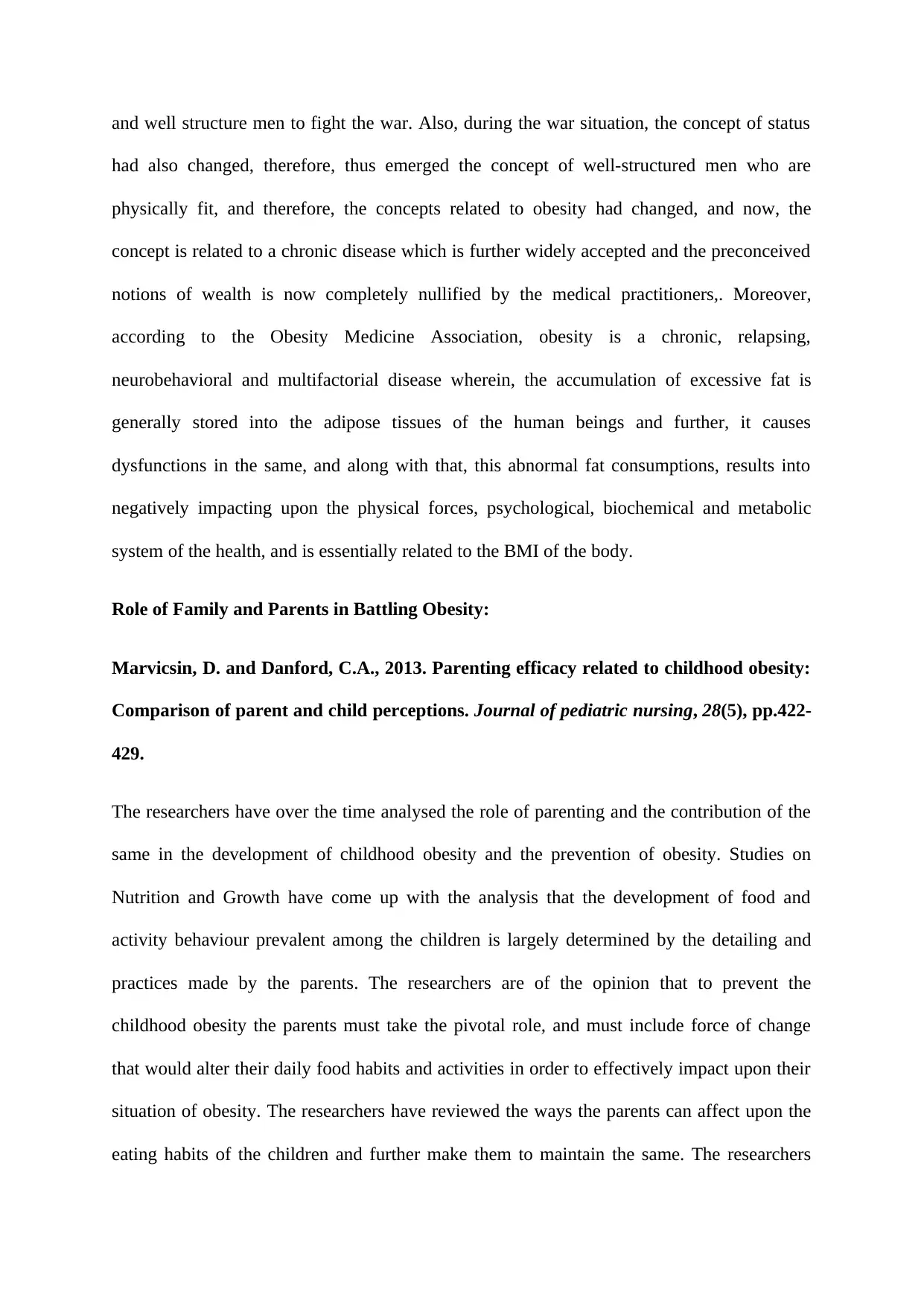
and well structure men to fight the war. Also, during the war situation, the concept of status
had also changed, therefore, thus emerged the concept of well-structured men who are
physically fit, and therefore, the concepts related to obesity had changed, and now, the
concept is related to a chronic disease which is further widely accepted and the preconceived
notions of wealth is now completely nullified by the medical practitioners,. Moreover,
according to the Obesity Medicine Association, obesity is a chronic, relapsing,
neurobehavioral and multifactorial disease wherein, the accumulation of excessive fat is
generally stored into the adipose tissues of the human beings and further, it causes
dysfunctions in the same, and along with that, this abnormal fat consumptions, results into
negatively impacting upon the physical forces, psychological, biochemical and metabolic
system of the health, and is essentially related to the BMI of the body.
Role of Family and Parents in Battling Obesity:
Marvicsin, D. and Danford, C.A., 2013. Parenting efficacy related to childhood obesity:
Comparison of parent and child perceptions. Journal of pediatric nursing, 28(5), pp.422-
429.
The researchers have over the time analysed the role of parenting and the contribution of the
same in the development of childhood obesity and the prevention of obesity. Studies on
Nutrition and Growth have come up with the analysis that the development of food and
activity behaviour prevalent among the children is largely determined by the detailing and
practices made by the parents. The researchers are of the opinion that to prevent the
childhood obesity the parents must take the pivotal role, and must include force of change
that would alter their daily food habits and activities in order to effectively impact upon their
situation of obesity. The researchers have reviewed the ways the parents can affect upon the
eating habits of the children and further make them to maintain the same. The researchers
had also changed, therefore, thus emerged the concept of well-structured men who are
physically fit, and therefore, the concepts related to obesity had changed, and now, the
concept is related to a chronic disease which is further widely accepted and the preconceived
notions of wealth is now completely nullified by the medical practitioners,. Moreover,
according to the Obesity Medicine Association, obesity is a chronic, relapsing,
neurobehavioral and multifactorial disease wherein, the accumulation of excessive fat is
generally stored into the adipose tissues of the human beings and further, it causes
dysfunctions in the same, and along with that, this abnormal fat consumptions, results into
negatively impacting upon the physical forces, psychological, biochemical and metabolic
system of the health, and is essentially related to the BMI of the body.
Role of Family and Parents in Battling Obesity:
Marvicsin, D. and Danford, C.A., 2013. Parenting efficacy related to childhood obesity:
Comparison of parent and child perceptions. Journal of pediatric nursing, 28(5), pp.422-
429.
The researchers have over the time analysed the role of parenting and the contribution of the
same in the development of childhood obesity and the prevention of obesity. Studies on
Nutrition and Growth have come up with the analysis that the development of food and
activity behaviour prevalent among the children is largely determined by the detailing and
practices made by the parents. The researchers are of the opinion that to prevent the
childhood obesity the parents must take the pivotal role, and must include force of change
that would alter their daily food habits and activities in order to effectively impact upon their
situation of obesity. The researchers have reviewed the ways the parents can affect upon the
eating habits of the children and further make them to maintain the same. The researchers
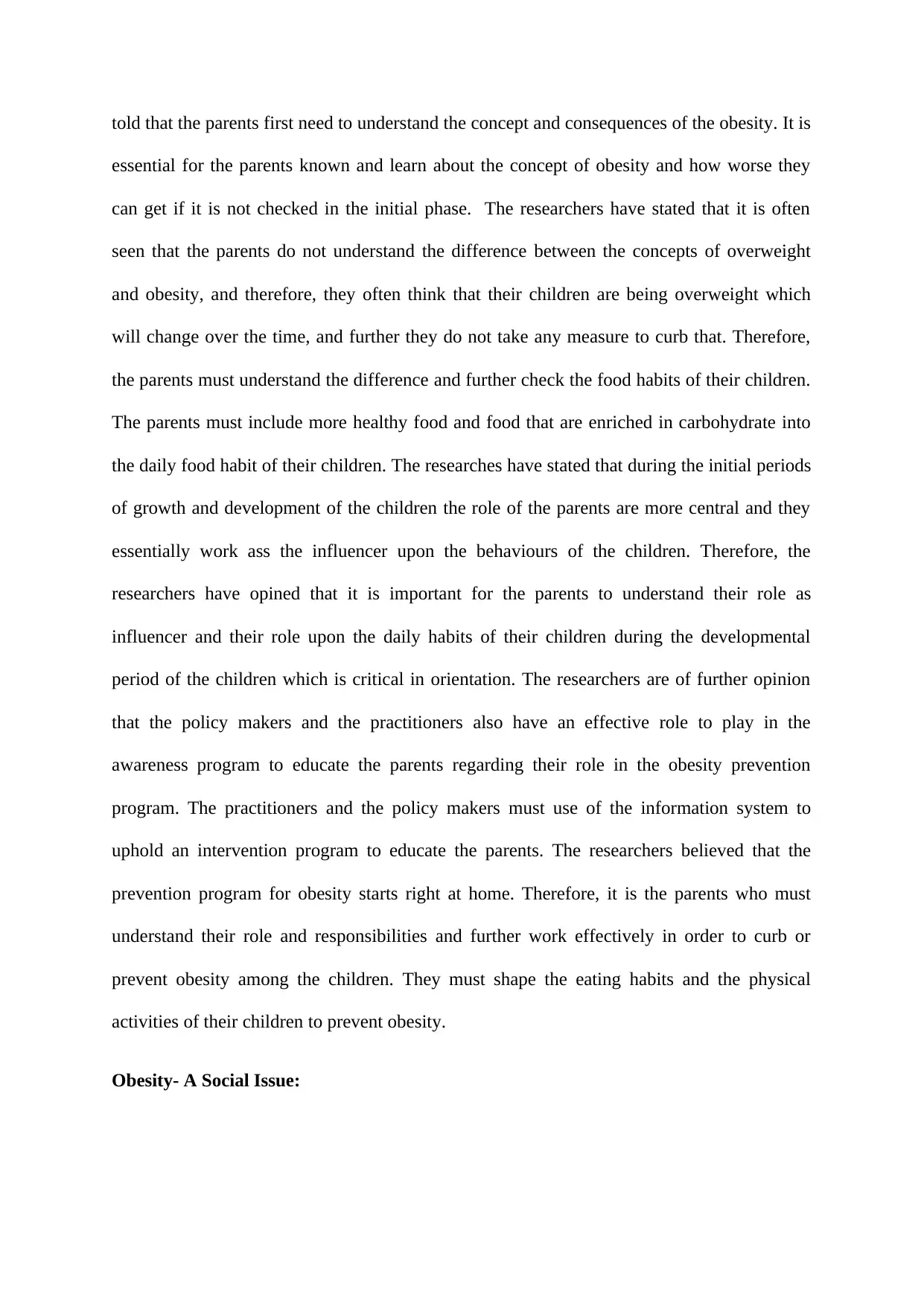
told that the parents first need to understand the concept and consequences of the obesity. It is
essential for the parents known and learn about the concept of obesity and how worse they
can get if it is not checked in the initial phase. The researchers have stated that it is often
seen that the parents do not understand the difference between the concepts of overweight
and obesity, and therefore, they often think that their children are being overweight which
will change over the time, and further they do not take any measure to curb that. Therefore,
the parents must understand the difference and further check the food habits of their children.
The parents must include more healthy food and food that are enriched in carbohydrate into
the daily food habit of their children. The researches have stated that during the initial periods
of growth and development of the children the role of the parents are more central and they
essentially work ass the influencer upon the behaviours of the children. Therefore, the
researchers have opined that it is important for the parents to understand their role as
influencer and their role upon the daily habits of their children during the developmental
period of the children which is critical in orientation. The researchers are of further opinion
that the policy makers and the practitioners also have an effective role to play in the
awareness program to educate the parents regarding their role in the obesity prevention
program. The practitioners and the policy makers must use of the information system to
uphold an intervention program to educate the parents. The researchers believed that the
prevention program for obesity starts right at home. Therefore, it is the parents who must
understand their role and responsibilities and further work effectively in order to curb or
prevent obesity among the children. They must shape the eating habits and the physical
activities of their children to prevent obesity.
Obesity- A Social Issue:
essential for the parents known and learn about the concept of obesity and how worse they
can get if it is not checked in the initial phase. The researchers have stated that it is often
seen that the parents do not understand the difference between the concepts of overweight
and obesity, and therefore, they often think that their children are being overweight which
will change over the time, and further they do not take any measure to curb that. Therefore,
the parents must understand the difference and further check the food habits of their children.
The parents must include more healthy food and food that are enriched in carbohydrate into
the daily food habit of their children. The researches have stated that during the initial periods
of growth and development of the children the role of the parents are more central and they
essentially work ass the influencer upon the behaviours of the children. Therefore, the
researchers have opined that it is important for the parents to understand their role as
influencer and their role upon the daily habits of their children during the developmental
period of the children which is critical in orientation. The researchers are of further opinion
that the policy makers and the practitioners also have an effective role to play in the
awareness program to educate the parents regarding their role in the obesity prevention
program. The practitioners and the policy makers must use of the information system to
uphold an intervention program to educate the parents. The researchers believed that the
prevention program for obesity starts right at home. Therefore, it is the parents who must
understand their role and responsibilities and further work effectively in order to curb or
prevent obesity among the children. They must shape the eating habits and the physical
activities of their children to prevent obesity.
Obesity- A Social Issue:
⊘ This is a preview!⊘
Do you want full access?
Subscribe today to unlock all pages.

Trusted by 1+ million students worldwide
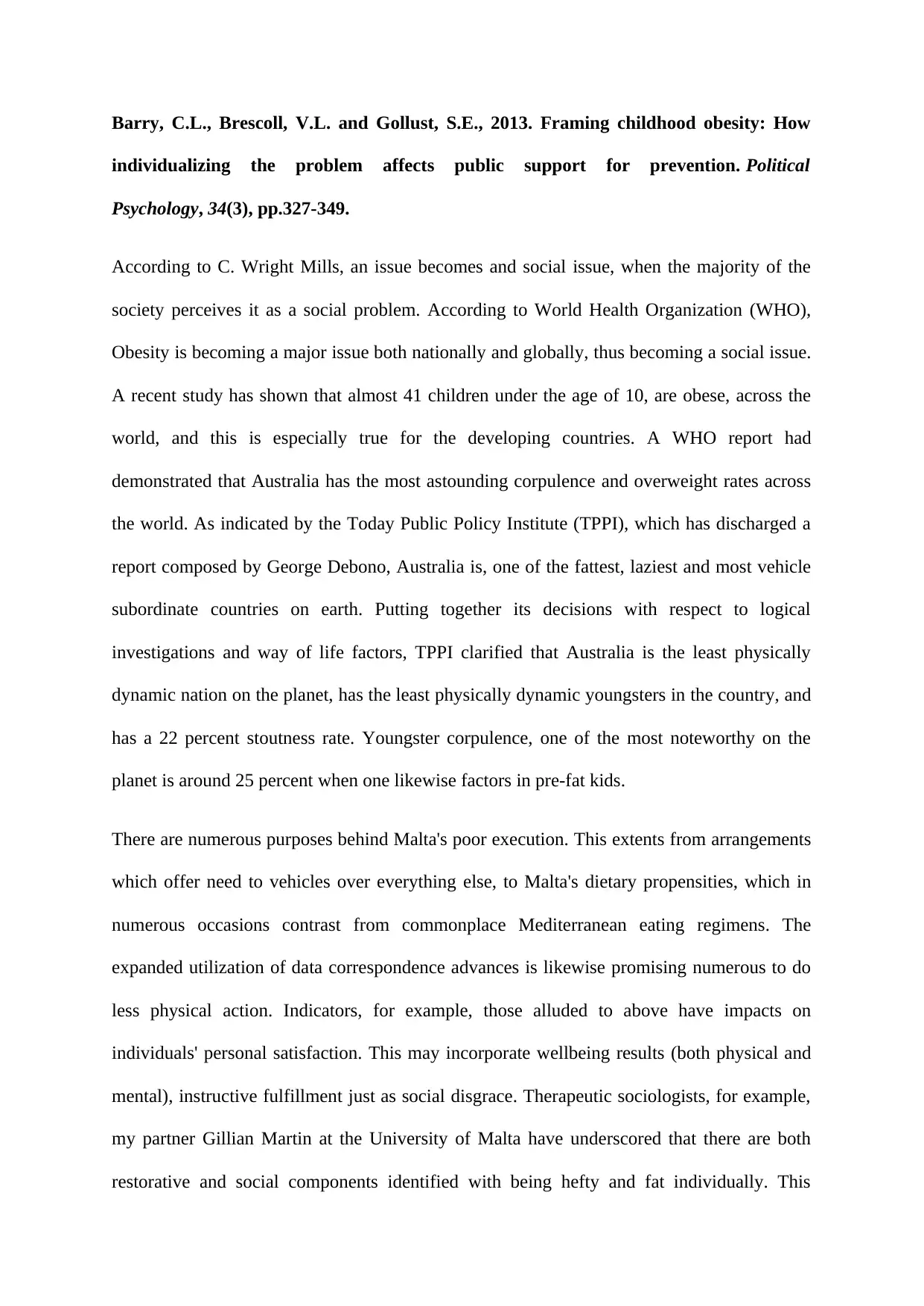
Barry, C.L., Brescoll, V.L. and Gollust, S.E., 2013. Framing childhood obesity: How
individualizing the problem affects public support for prevention. Political
Psychology, 34(3), pp.327-349.
According to C. Wright Mills, an issue becomes and social issue, when the majority of the
society perceives it as a social problem. According to World Health Organization (WHO),
Obesity is becoming a major issue both nationally and globally, thus becoming a social issue.
A recent study has shown that almost 41 children under the age of 10, are obese, across the
world, and this is especially true for the developing countries. A WHO report had
demonstrated that Australia has the most astounding corpulence and overweight rates across
the world. As indicated by the Today Public Policy Institute (TPPI), which has discharged a
report composed by George Debono, Australia is, one of the fattest, laziest and most vehicle
subordinate countries on earth. Putting together its decisions with respect to logical
investigations and way of life factors, TPPI clarified that Australia is the least physically
dynamic nation on the planet, has the least physically dynamic youngsters in the country, and
has a 22 percent stoutness rate. Youngster corpulence, one of the most noteworthy on the
planet is around 25 percent when one likewise factors in pre-fat kids.
There are numerous purposes behind Malta's poor execution. This extents from arrangements
which offer need to vehicles over everything else, to Malta's dietary propensities, which in
numerous occasions contrast from commonplace Mediterranean eating regimens. The
expanded utilization of data correspondence advances is likewise promising numerous to do
less physical action. Indicators, for example, those alluded to above have impacts on
individuals' personal satisfaction. This may incorporate wellbeing results (both physical and
mental), instructive fulfillment just as social disgrace. Therapeutic sociologists, for example,
my partner Gillian Martin at the University of Malta have underscored that there are both
restorative and social components identified with being hefty and fat individually. This
individualizing the problem affects public support for prevention. Political
Psychology, 34(3), pp.327-349.
According to C. Wright Mills, an issue becomes and social issue, when the majority of the
society perceives it as a social problem. According to World Health Organization (WHO),
Obesity is becoming a major issue both nationally and globally, thus becoming a social issue.
A recent study has shown that almost 41 children under the age of 10, are obese, across the
world, and this is especially true for the developing countries. A WHO report had
demonstrated that Australia has the most astounding corpulence and overweight rates across
the world. As indicated by the Today Public Policy Institute (TPPI), which has discharged a
report composed by George Debono, Australia is, one of the fattest, laziest and most vehicle
subordinate countries on earth. Putting together its decisions with respect to logical
investigations and way of life factors, TPPI clarified that Australia is the least physically
dynamic nation on the planet, has the least physically dynamic youngsters in the country, and
has a 22 percent stoutness rate. Youngster corpulence, one of the most noteworthy on the
planet is around 25 percent when one likewise factors in pre-fat kids.
There are numerous purposes behind Malta's poor execution. This extents from arrangements
which offer need to vehicles over everything else, to Malta's dietary propensities, which in
numerous occasions contrast from commonplace Mediterranean eating regimens. The
expanded utilization of data correspondence advances is likewise promising numerous to do
less physical action. Indicators, for example, those alluded to above have impacts on
individuals' personal satisfaction. This may incorporate wellbeing results (both physical and
mental), instructive fulfillment just as social disgrace. Therapeutic sociologists, for example,
my partner Gillian Martin at the University of Malta have underscored that there are both
restorative and social components identified with being hefty and fat individually. This
Paraphrase This Document
Need a fresh take? Get an instant paraphrase of this document with our AI Paraphraser
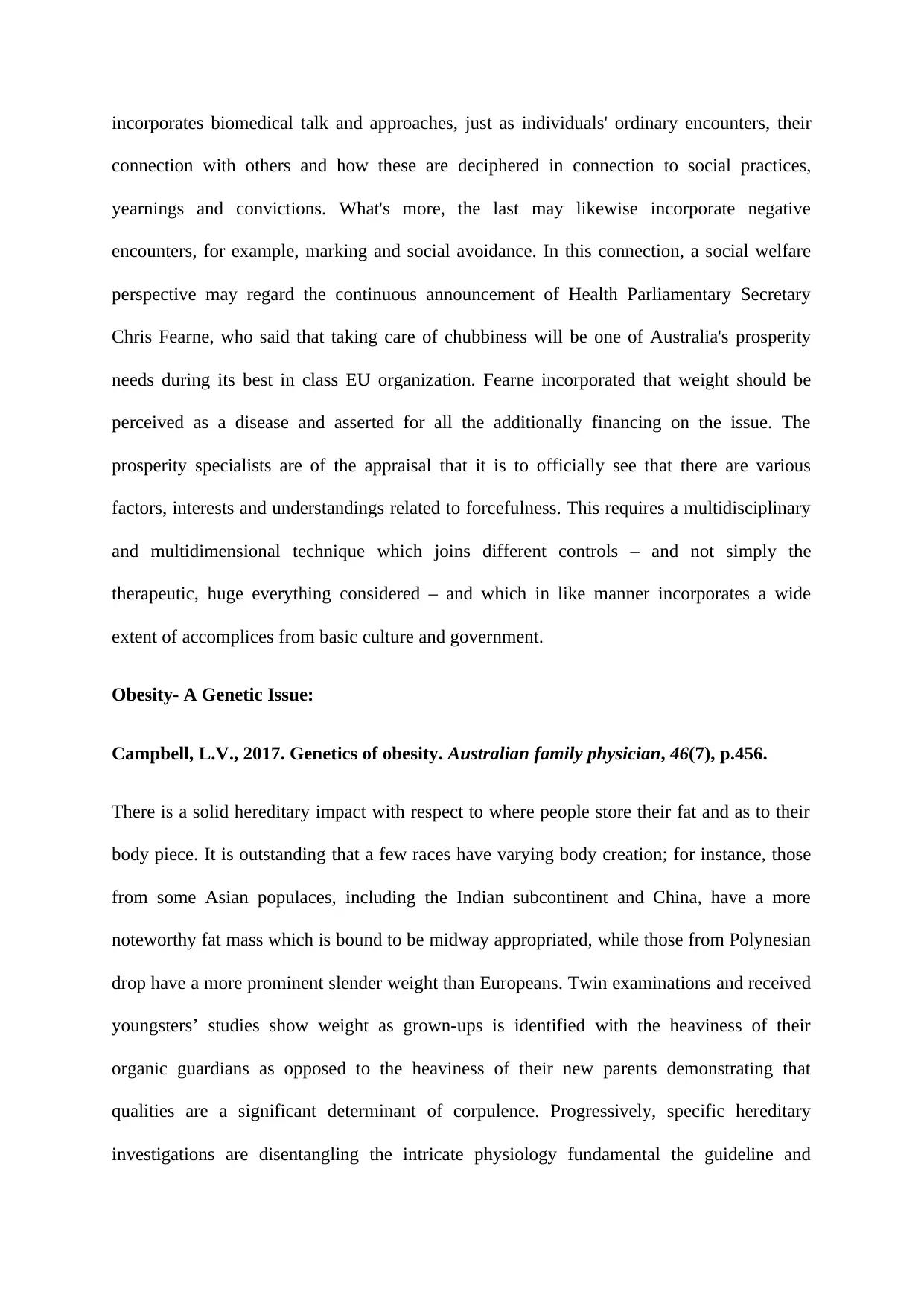
incorporates biomedical talk and approaches, just as individuals' ordinary encounters, their
connection with others and how these are deciphered in connection to social practices,
yearnings and convictions. What's more, the last may likewise incorporate negative
encounters, for example, marking and social avoidance. In this connection, a social welfare
perspective may regard the continuous announcement of Health Parliamentary Secretary
Chris Fearne, who said that taking care of chubbiness will be one of Australia's prosperity
needs during its best in class EU organization. Fearne incorporated that weight should be
perceived as a disease and asserted for all the additionally financing on the issue. The
prosperity specialists are of the appraisal that it is to officially see that there are various
factors, interests and understandings related to forcefulness. This requires a multidisciplinary
and multidimensional technique which joins different controls – and not simply the
therapeutic, huge everything considered – and which in like manner incorporates a wide
extent of accomplices from basic culture and government.
Obesity- A Genetic Issue:
Campbell, L.V., 2017. Genetics of obesity. Australian family physician, 46(7), p.456.
There is a solid hereditary impact with respect to where people store their fat and as to their
body piece. It is outstanding that a few races have varying body creation; for instance, those
from some Asian populaces, including the Indian subcontinent and China, have a more
noteworthy fat mass which is bound to be midway appropriated, while those from Polynesian
drop have a more prominent slender weight than Europeans. Twin examinations and received
youngsters’ studies show weight as grown-ups is identified with the heaviness of their
organic guardians as opposed to the heaviness of their new parents demonstrating that
qualities are a significant determinant of corpulence. Progressively, specific hereditary
investigations are disentangling the intricate physiology fundamental the guideline and
connection with others and how these are deciphered in connection to social practices,
yearnings and convictions. What's more, the last may likewise incorporate negative
encounters, for example, marking and social avoidance. In this connection, a social welfare
perspective may regard the continuous announcement of Health Parliamentary Secretary
Chris Fearne, who said that taking care of chubbiness will be one of Australia's prosperity
needs during its best in class EU organization. Fearne incorporated that weight should be
perceived as a disease and asserted for all the additionally financing on the issue. The
prosperity specialists are of the appraisal that it is to officially see that there are various
factors, interests and understandings related to forcefulness. This requires a multidisciplinary
and multidimensional technique which joins different controls – and not simply the
therapeutic, huge everything considered – and which in like manner incorporates a wide
extent of accomplices from basic culture and government.
Obesity- A Genetic Issue:
Campbell, L.V., 2017. Genetics of obesity. Australian family physician, 46(7), p.456.
There is a solid hereditary impact with respect to where people store their fat and as to their
body piece. It is outstanding that a few races have varying body creation; for instance, those
from some Asian populaces, including the Indian subcontinent and China, have a more
noteworthy fat mass which is bound to be midway appropriated, while those from Polynesian
drop have a more prominent slender weight than Europeans. Twin examinations and received
youngsters’ studies show weight as grown-ups is identified with the heaviness of their
organic guardians as opposed to the heaviness of their new parents demonstrating that
qualities are a significant determinant of corpulence. Progressively, specific hereditary
investigations are disentangling the intricate physiology fundamental the guideline and
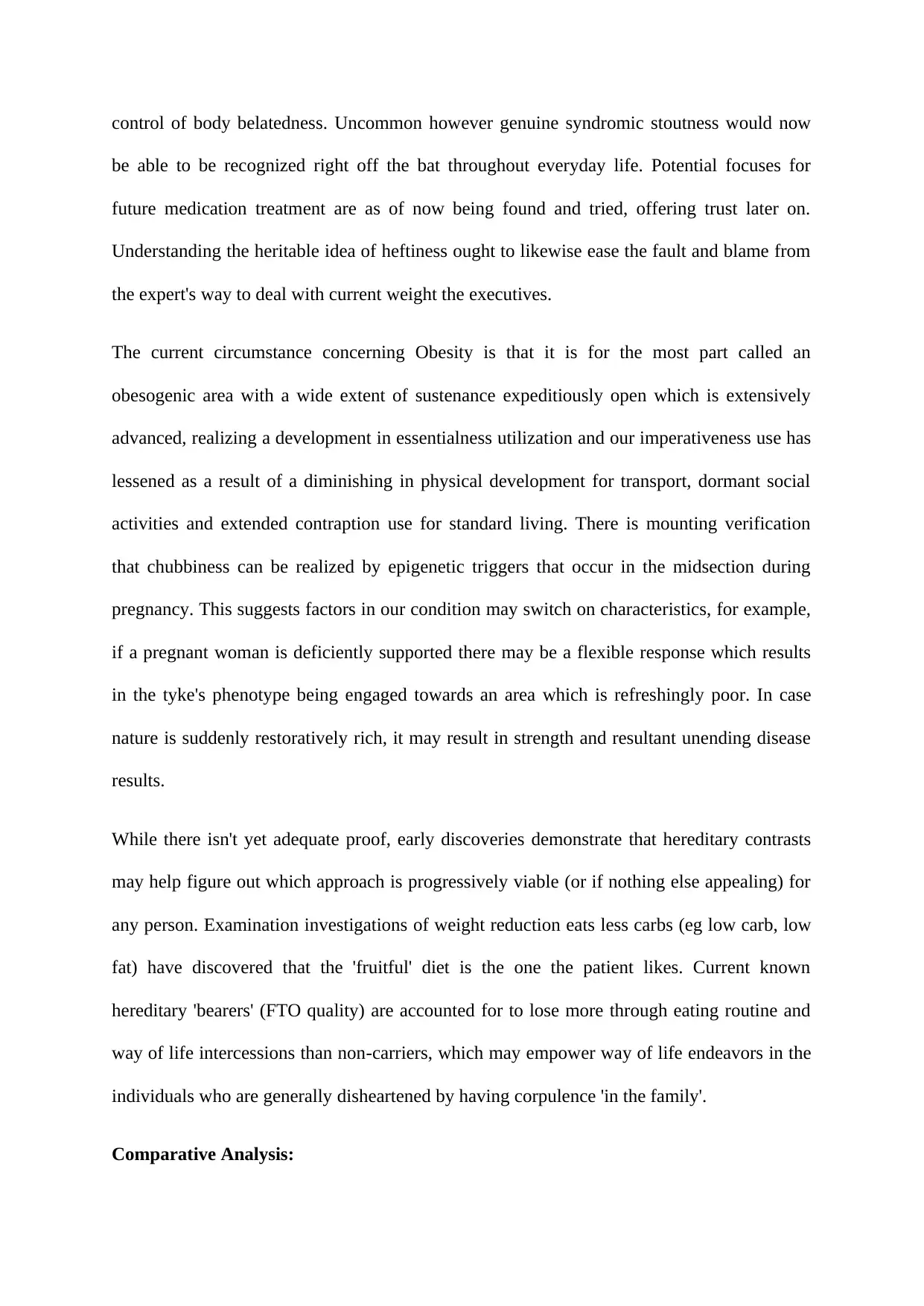
control of body belatedness. Uncommon however genuine syndromic stoutness would now
be able to be recognized right off the bat throughout everyday life. Potential focuses for
future medication treatment are as of now being found and tried, offering trust later on.
Understanding the heritable idea of heftiness ought to likewise ease the fault and blame from
the expert's way to deal with current weight the executives.
The current circumstance concerning Obesity is that it is for the most part called an
obesogenic area with a wide extent of sustenance expeditiously open which is extensively
advanced, realizing a development in essentialness utilization and our imperativeness use has
lessened as a result of a diminishing in physical development for transport, dormant social
activities and extended contraption use for standard living. There is mounting verification
that chubbiness can be realized by epigenetic triggers that occur in the midsection during
pregnancy. This suggests factors in our condition may switch on characteristics, for example,
if a pregnant woman is deficiently supported there may be a flexible response which results
in the tyke's phenotype being engaged towards an area which is refreshingly poor. In case
nature is suddenly restoratively rich, it may result in strength and resultant unending disease
results.
While there isn't yet adequate proof, early discoveries demonstrate that hereditary contrasts
may help figure out which approach is progressively viable (or if nothing else appealing) for
any person. Examination investigations of weight reduction eats less carbs (eg low carb, low
fat) have discovered that the 'fruitful' diet is the one the patient likes. Current known
hereditary 'bearers' (FTO quality) are accounted for to lose more through eating routine and
way of life intercessions than non-carriers, which may empower way of life endeavors in the
individuals who are generally disheartened by having corpulence 'in the family'.
Comparative Analysis:
be able to be recognized right off the bat throughout everyday life. Potential focuses for
future medication treatment are as of now being found and tried, offering trust later on.
Understanding the heritable idea of heftiness ought to likewise ease the fault and blame from
the expert's way to deal with current weight the executives.
The current circumstance concerning Obesity is that it is for the most part called an
obesogenic area with a wide extent of sustenance expeditiously open which is extensively
advanced, realizing a development in essentialness utilization and our imperativeness use has
lessened as a result of a diminishing in physical development for transport, dormant social
activities and extended contraption use for standard living. There is mounting verification
that chubbiness can be realized by epigenetic triggers that occur in the midsection during
pregnancy. This suggests factors in our condition may switch on characteristics, for example,
if a pregnant woman is deficiently supported there may be a flexible response which results
in the tyke's phenotype being engaged towards an area which is refreshingly poor. In case
nature is suddenly restoratively rich, it may result in strength and resultant unending disease
results.
While there isn't yet adequate proof, early discoveries demonstrate that hereditary contrasts
may help figure out which approach is progressively viable (or if nothing else appealing) for
any person. Examination investigations of weight reduction eats less carbs (eg low carb, low
fat) have discovered that the 'fruitful' diet is the one the patient likes. Current known
hereditary 'bearers' (FTO quality) are accounted for to lose more through eating routine and
way of life intercessions than non-carriers, which may empower way of life endeavors in the
individuals who are generally disheartened by having corpulence 'in the family'.
Comparative Analysis:
⊘ This is a preview!⊘
Do you want full access?
Subscribe today to unlock all pages.

Trusted by 1+ million students worldwide
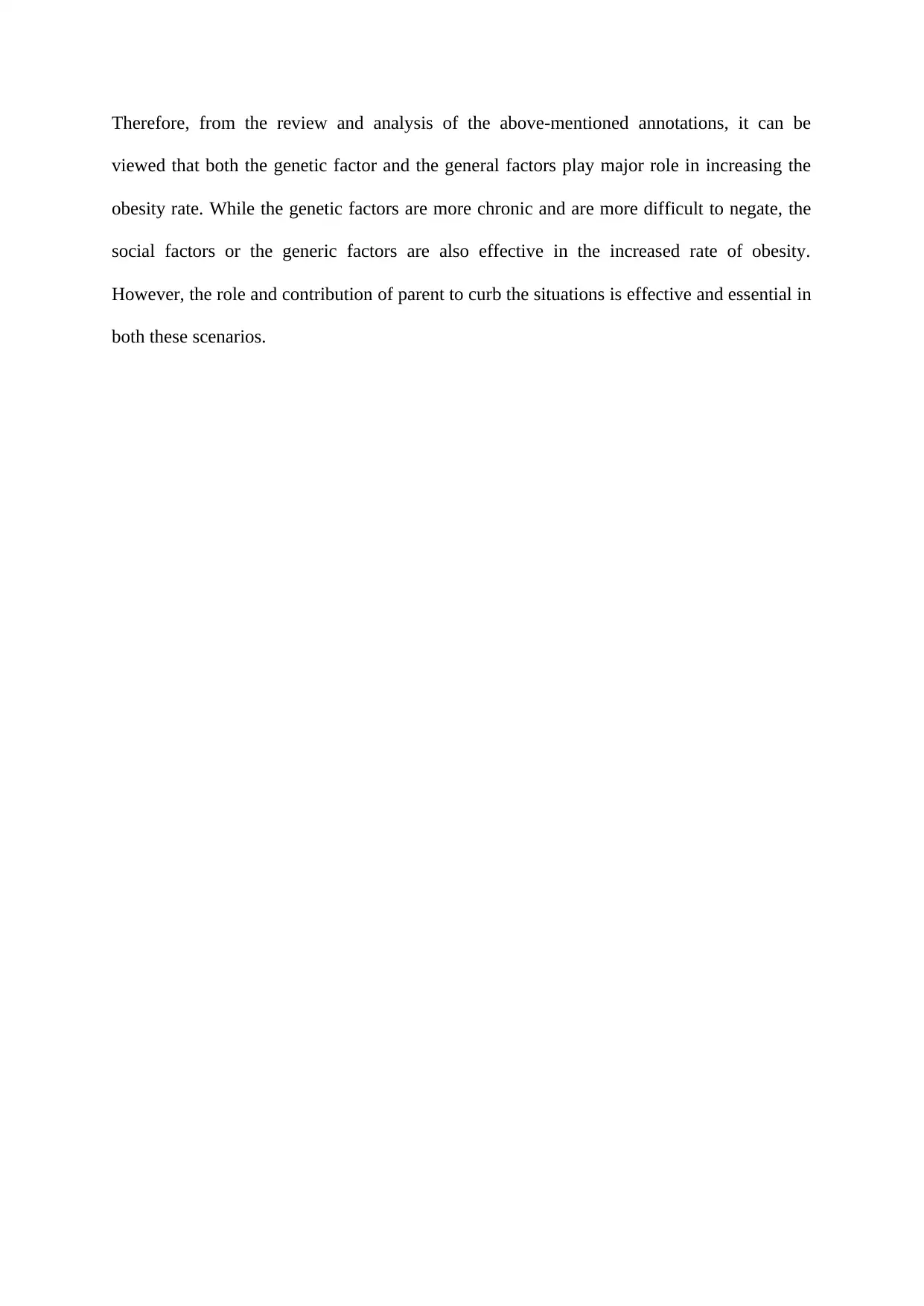
Therefore, from the review and analysis of the above-mentioned annotations, it can be
viewed that both the genetic factor and the general factors play major role in increasing the
obesity rate. While the genetic factors are more chronic and are more difficult to negate, the
social factors or the generic factors are also effective in the increased rate of obesity.
However, the role and contribution of parent to curb the situations is effective and essential in
both these scenarios.
viewed that both the genetic factor and the general factors play major role in increasing the
obesity rate. While the genetic factors are more chronic and are more difficult to negate, the
social factors or the generic factors are also effective in the increased rate of obesity.
However, the role and contribution of parent to curb the situations is effective and essential in
both these scenarios.
1 out of 7
Related Documents
Your All-in-One AI-Powered Toolkit for Academic Success.
+13062052269
info@desklib.com
Available 24*7 on WhatsApp / Email
![[object Object]](/_next/static/media/star-bottom.7253800d.svg)
Unlock your academic potential
Copyright © 2020–2025 A2Z Services. All Rights Reserved. Developed and managed by ZUCOL.





